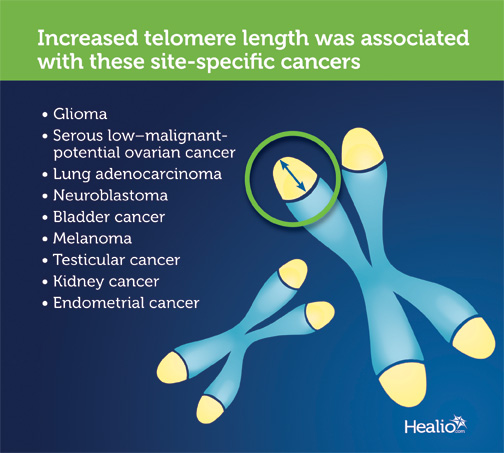Longer telomeres associated with increased cancer risk
Longer telomeres appeared to increase the risk for various cancers, but reduced the risk for non-neoplastic diseases, including cardiovascular diseases, according to findings published in JAMA Oncology.
“These findings suggest that potential clinical applications based on telomere length — eg, as a tool for risk prediction or as an intervention target for disease prevention — may have to consider a tradeoff in risk between cancer and other diseases,” Philip C. Haycock, PhD, MPhil, senior research associate in the integrative epidemiology unit of the University of Bristol in the United Kingdom, told HemOnc Today.
“For example, a number of companies offer telomere length measurement services to the public, claiming that shorter telomeres are a general indicator of poorer health status and older biological age, and that such information can be used to motivate healthy lifestyle choices in individuals,” Haycock added. “However, the conflicting direction of association between telomere length and risk of cancer and other diseases suggests that such services to the general public may be premature."
Telomeres, located at the end of chromosomes, are DNA protein structures that protect the genome from damage. Telomeres “shorten over time in most somatic tissues and are proposed physiological markers of aging,” Haycock and colleagues wrote.
Researchers have previously correlated shorter leukocyte telomeres with older age, male sex and risk factors for noncommunicable diseases. Further, shorter telomeres are associated with greater risk for type 2 diabetes and nonvascular, non-neoplastic causes of mortality.
“Whether these associations are causal, however, is unknown,” the researchers added. “Telomere length has also been implicated in risk for cancer, but the direction and magnitude of the association is uncertain and contradictory across observational studies.”
The researchers performed a Mendelian randomization study using genomewide association studies published through January 15, 2015. The analysis included 103 studies of noncommunicable diseases that assayed germline genetic variants and did not use preexisting diseases to select participants.
Overall, the researchers reviewed summary data for 35 cancers and 48 non-neoplastic diseases, corresponding to 420,081 cases (median, 2,526 per disease) and 1,093,105 controls (median, 6,789 per disease).
Increased telomere length due to germline genetic variation was associated with an increased risk for site-specific cancers.
These diseases covered a wide array of cancers, including glioma (OR per standard deviation higher telomere length = 5.27; 95% CI, 3.15-8.81); serous low–malignant-potential ovarian cancer (OR = 4.35; 95% CI, 2.39-7.94), lung adenocarcinoma (OR = 3.19; 95% CI, 2.4-4.22), neuroblastoma (OR = 2.98; 95% CI, 1.92-4.62), bladder cancer (OR = 2.19; 95% CI, 1.32-3.66), melanoma (OR = 1.87; 95% CI, 1.55-2.26), testicular cancer (OR = 1.76; 95% CI, 1.02-3.04), kidney cancer (OR = 1.55; 95% CI, 1.08-2.23 and endometrial cancer (OR = 1.31; 95% CI, 1.07-1.61).
Associations tended to be stronger for rarer cancers and for cancers that occur at tissue sites where rates of stem cell division were lower, the researchers wrote.
There was little evidence of an association between genetically longer telomere length and risk for autoimmune, psychiatric, inflammatory, diabetic and other diseases; however, researchers observed decreased risks for coronary heart disease (OR = 0.78; 95% CI, 0.67-0.9), abdominal aortic aneurysm (OR = 0.63; 95% CI, 0.49-0.81), celiac disease (OR = 0.42; 95% CI, 0.28-0.61) and interstitial lung disease (OR = 0.09; 95% CI, 0.05-0.15).
“Further research is required to resolve whether telomere length is a useful predictor of risk that can help guide therapeutic interventions, to clarify the shape of any dose–response relationships and to characterize the nature of the association in population subgroups,” the researchers wrote.
– by Andy Polhamus
Disclosure: Haycock reports no relevant financial disclosures. Please see the full study for a list of all other researchers’ relevant financial disclosures.


